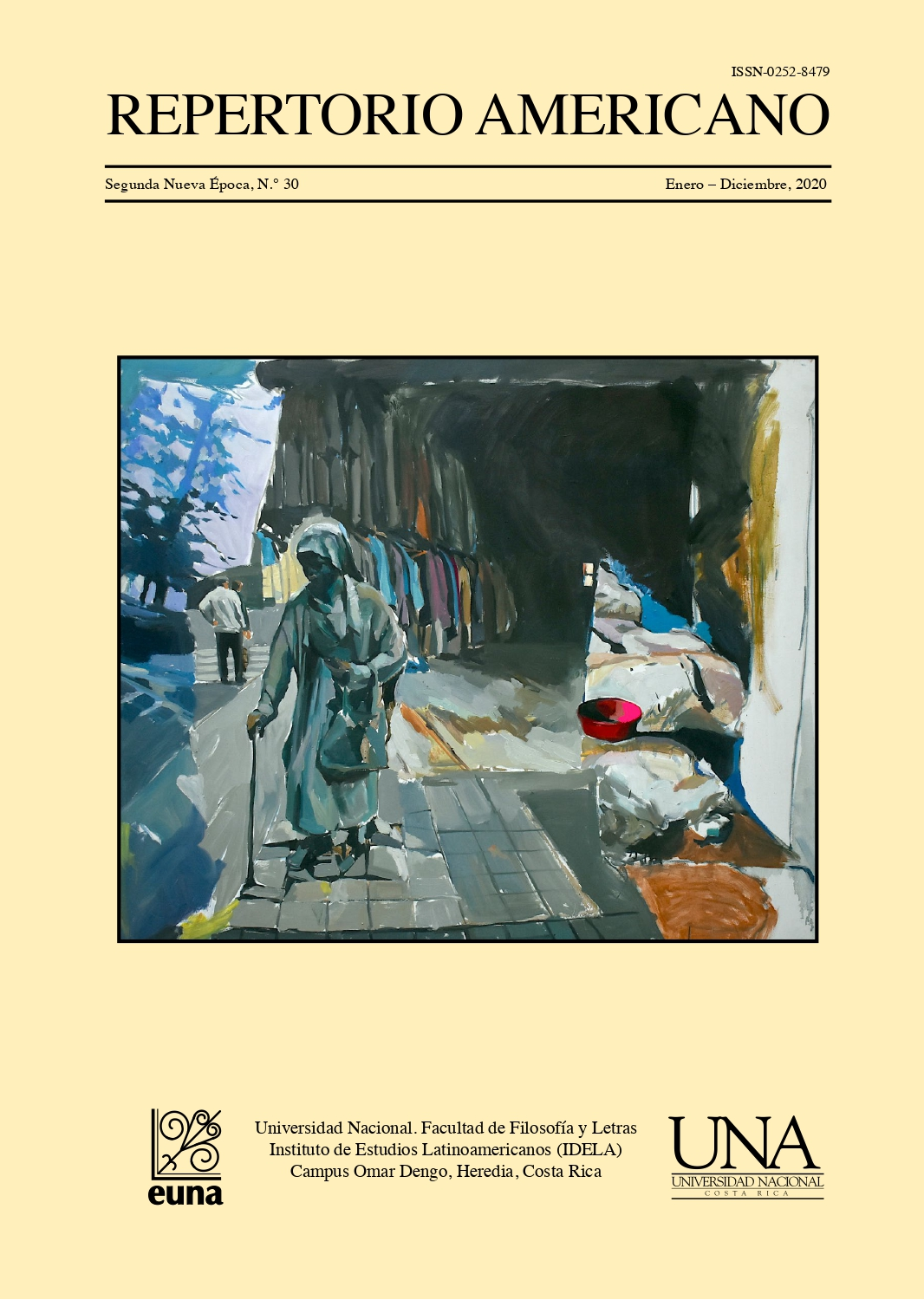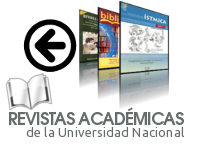Binary oppositions revisited: Nature and the reconciliation of opposites in Kinnell’s The book of nightmares
DOI:
https://doi.org/10.15359/ra.1-30.15Palabras clave:
literatura estadounidense, poesía, Jung, Campbell, oposiciones binariasResumen
El poemario El libro de las pesadillas de Galway Kinnell es abundante en imágenes de la naturaleza que facilitan una mejor comprensión de la oposición binaria vida y muerte. Aparentemente contradictorios, ambos conceptos pueden ser difíciles de comprender como elementos de una única
unidad en tanto que, a muchas personas, especialmente educadas en la sociedad occidental, se les enseña a apreciar la vida y desdeñar la muerte. Sin embargo, esta última es clave en esta relación binaria. Para el propósito de este trabajo de investigación se utilizará el enfoque arquetípico jungiano y el aporte de Campbell con referencia al mito. Indiscutiblemente, en este poemario, Kinnell logra revelar la relación ancestral del ser humano con la realidad vida-muerte por medio de las imágenes de la naturaleza. Consecuentemente, el yo lírico utiliza imágenes como la lluvia, las piedras del camino (entre otras) y diferentes tipos de animales para crear un mundo poético con el que los individuos puedan relacionarse.
Referencias
Achtemeier, P. ed. (1985). The HarperCollins Bible Dictionary. New York:
Harper Collins Publishers.
Adamski, S. (2011). Archetypes and the
collective unconscious of Carl
G. Jung in the light of quantum
psychology. NeuroQuantology, 9
(3), 563-571. Retrieved from http://
citeseerx.ist.psu.edu/viewdoc/down
load?doi=10.1.1.921.5519&rep=re
p1&type=pdf
Barthes, R. (1977). Ensayos críticos. Barcelona: Editorial Seix Barral.
Barthes, R. (1999). Mythologies. New
York: Hill and Wang.
Biedermann, H. (1992). Dictionary of
symbolism (J. Hulbert, Trans.) New
York: Facts on File. (Original work
published in 1989).
Bodkin. M. (1951). Archetypal patterns in
poetry. London: Oxford University
Press.
Bourdieu, P. (1991). Language and symbolic power. Ed. and Intro. John B.
Thompson. (Raymond, G. & Admason, M., Trans). Massachusets:
Harvard University Press.
Calhoun, R. (1992). Galway Kinnell. New
York: Twayne Publishers.
Campbell, J. (1972). Myths to live by. New
York: The Viking Press.
Campbell, J. (1991). The power of myth.
New York: Anchor Books.
Campbell, J. (2004a). Pathways to bliss.
California: New World Library.
Campbell, J. (2004b). The hero with a
thousand faces. Boston: Princeton
University Press.
Cirlot, J.C. (1962). A Dictionary of symbols. London: Routledge.
Cuddon, J. A. (1976). A Dictionary of literary terms. Middlesex: Penguin
Books.
DeNiord, C., & Kinnell, G. (2011). An interview with Galway Kinnell. The
American Poetry Review, 40(1),
-11. Retrieved from http://www.
jstor.org/stable/23053002
Dundes, A. (1997). Binary opposition in
myth: The Propp/Lévi-Strauss debate in retrospect. Western Folklore,
(1), 39-50. doi:10.2307/1500385
Eagleton, T. (1996). Literary theory: An
introduction. Massachusetts: Blackwell Publishing.
Edelman, S. P. (1981). The poet as healer.
Southwest Review, 66(2), 215–219.
Retrieved from: JSTOR, www.jstor.
org/stable/43469347.
Edinger, E. (1992). Ego and archetype.
Massachusetts: Shambhala Publications, Inc.
Ferber, M. (1999). A dictionary of literary
symbols. Cambridge: Cambridge
University Press.
García, A. A. (2010). “In the Shadow of
a Mosque: Mapping the “Song
of Roland”.” The French Review,
(2), 311-25. http://www.jstor.
org.ezproxy.sibdi.ucr.ac.cr:2048/
stable/25758409.
Gardner, T., & Kinnell, G. (1979). An
interview with Galway Kinnell.
Contemporary Literature, 20(4),
-433. doi:10.2307/1207901
Gross, H. (1974). The problem of style
and the poetry of the sixties. The
Iowa Review, 5(1), 69-74. Retrieved from http://www.jstor.org/
stable/20158188
Henderson, J. L. (1995). Reflections on
the history and practice of Jungian
analysis. In M. Stein, ed., Jungian
analysis (2nd ed.). Chicago and La
Salle, IL: Open Court. pp. 10-15.
Hyman, S. (1955). The ritual view of myth
and the mythic. The Journal of
American Folklore, 68(270), 462-
doi:10.2307/53677.
Jung. C. G. (1959). The archetypes and
the collective unconscious. London:
Routledge & Kegan Paul.
Jung, C. G. (1964). Man and his symbols.
New York: Dell Publishing Co., Inc.
Jung, C. G. (1961). Memories, dreams, reflections. New York: Pantheon.
Jung, C. G. (1970). Four archetypes. Boston: Princeton University Press.
Jung, C. G. (2006). The undiscovered self. New York: A Signet Book.
Jung, C.G. (2010). Modern man in search
of a soul. New York: Hartcourt, Inc.
Kinnell, G., Gerber, P., Gemmett, R.,
Gerald, G., & Heyen, W. (1970).
“Deeper than Personality”: A Conversation with Galway Kinnell. The
Iowa Review, 1(2), 125-133. Retrieved from http://www.jstor.org/
stable/20157582
Kinnell, G. (1971a). The book of nightmares. Boston: Houghton Mifflin
Company
Kinnell, G. (1971b). The poetics of the
physical world. The Iowa Review,
(3), 103-126. Retrieved from
https://ir.uiowa.edu/cgi/viewcontent.cgi?article=1251&context=iow
areview
Kinnell, G. (1978). Walking down the
stairs: Selections from interviews.
Michigan: The University of Michigan Press.
Kinnell, G., & McKenzie, J. (1973). To
the roots: an interview with Galway
Kinnell. Salmagundi, 22/23, 206-
Retrieved from http://www.
jstor.org/stable/40546780
Kinnell, G., Poulin, A., & Rubin, S.
(1976). Interview with A. Poulin, Jr.
and Stan Samuel Rubin. The American Poetry Review, 5(4), 6-7. Retrieved from http://www.jstor.org/
stable/27775318
Kleinbard, D. (1986). Galway Kinnell’s
poetry of transformation. The Centennial Review, 30(1), 41-56. Retrieved from http://www.jstor.org/
stable/23738612
Lévi-Strauss, C. (1955). The structural
study of myth. The Journal of American Folklore, 68(270), 428-444.
doi:10.2307/536768
Lévi-Strauss, C. (1978). Myth and meaning. London: Routledge and Kegan Paul.
Mackey, L. (1981). Anatomical curiosities: Northrop Frye’s theory of criticism. Texas Studies in Literature
and Language, 23(3), 442-469.
Retrieved from http://www.jstor.
org.ezproxy.sibdi.ucr.ac.cr:2048/
stable/40754656
MacShane, F. (1968). Of writing and
writers: The new poetry. The American Scholar, 37(4), 642-646. Retrieved from http://www.jstor.org/
stable/41209609
Malamud, R. (2000). The culture of
using animals in literature and
the case of Jose Emilio Pacheco.
CLCWeb: Comparative Literature and Culture 2.2: https://doi.
org//10.771/1481-4374.1072
Marcello, L. L. (1976). Galway Kinnell:
Adamic poet and deep imagist.
Available from ProQuest Dissertations & Theses A&I. (288265041).
Retrieved from http://search.proquest.com/docview/288265041?ac
countid=32236
Mills, R.J., Jr. (1970a). A reading of Galway Kinnell. The Iowa Review,1(1),
-86. Retrieved from http://www.
jstor.org/stable/20157537
Mills, R.J., Jr. (1970b). A reading of Galway Kinnell: Part 2 (Continued).
The Iowa Review, 1(2), 102-122.
Retrieved from http://www.jstor.
org/stable/20157579
Mills, R. J., Jr. (1975). Cry of the human
essays on contemporary American
poetry. Chicago: University of Illinois Press.
Nandi, R. (2016). Archetypal approach
to Eliot’s “The Wasteland.” An Interdisciplinary Journal of Literary
Studies, 1(1), 57-66. Retrieved
from http://postscriptum.co.in/wpcontent/uploads/2016/09/RINKUNANDI.pdf
Nelson, H. (1987). On the poetry of Galway Kinnell. Michigan: The University of Michigan Press.
Pagel, W. (1948). Jung’s views on Alchemy. Isis, 39(1/2), 44-48. Retrieved
from http://www.jstor.org.ezproxy.
sibdi.ucr.ac.cr:2048/stable/226767.
Paz, O. (1995). El laberinto de la soledad.
Madrid: Ediciones Cátedra.
Rosenthal, M.L. & Gall, S. M. (1983). The
modern poetic sequence. Oxford:
Oxford University Press.
Rowland, S. (1999). C.G. Jung and literary theory: The challenge from fiction. New York: St. Martin’s Press.
Sabini, M., ed., (2001). C.G. Jung. The
earth has a soul: Jung on nature,
technology & modern life. (1st ed).
California: North Atlantic Books.
Selden, R. (1989). Practicing theory and
reading literature. Kentucky: The
University Press of Kentucky.
Selden, R. & Widdowson, P. (1993). A
reader’s guide to contemporary literary theory. Kentucky: The University Press of Kentucky.
Scheffler, T. (1981). The ideology of binary opposition: Subject/object
duality and anthropology. Dialectical Anthropology, 6(2), 165-169.
Retrieved from http://www.jstor.
org.ezproxy.sibdi.ucr.ac.cr:2048/
stable/29790030
Storr, A. (1989). The essential Jung. Boston: Princeton University Press.
Sugg, R., eds. (1992). Jungian Literary
Criticism. Evanston, Illinois: Northwestern University Press.
Taha, A. (n.d.) The allegorical use of
the rituals of hunting in Galway
Kinnell’s “The Bear”. (n.ed.). Retrieved from:http://www.iasj.net/
iasj?func=fulltext&aId=81622
The Poetry of Galway Kinnell. Literary
Cavalcade, 53(1), 2000, 16-18. Retrieved from http://search.proquest.
com/docview/210471429?account
id=32236
Toskar, S. (1981). Galway Kinnell’s
The book of nightmares: The
wages of dying is love. Hokusei Gakuen University, 19, 361-
Retrieved from https://ci.nii.
ac.jp/els/contents110000338332.
pdf?id=ART0000775706
Townsend, D. (1972). Myth and meaning. The Centennial Review, 16(2),
-202. Retrieved from http://
www.jstor.org.ezproxy.sibdi.ucr.
ac.cr:2048/stable/23738355
Tuten, N. (1992). The language of sexuality: Walt Whitman and Galway Kinnell. Walt Whitman
Quarterly Review, 9, 134-141.
Retrieved from http://dx.doi.
org/10.13008/2153-3695.1325
Tuten, N. (1996). Critical essays on Galway Kinnell. New York: G.K. Hall
&Co.
Zimmerman, L. (1987). The poetry of Galway Kinnell. Chicago: University
of Illinois Press.
Publicado
Cómo citar
Número
Sección
Licencia
Las cartas de entendimiento se facilitarán a las personas autoras al momento de aceptación de su trabajo para publicarse.
Todos los contenidos son de libre acceso con sólo citar la fuente.







